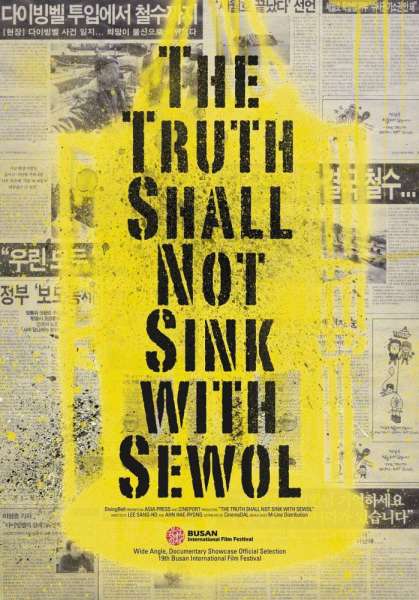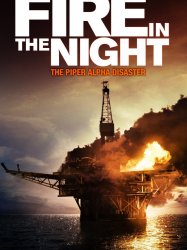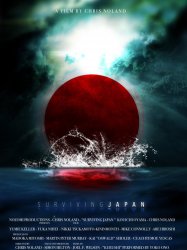Diving Bell : The Truth Shall Not Sink with Sewol est un film de genre Documentaire
Diving Bell : The Truth Shall Not Sink with Sewol (2014)

Si vous aimez ce film, faites-le savoir !
Durée 1h17
Genres Documentaire
Themes La mer, Transport, Documentaire historique, Documentaire sur les technologies, Film catastrophe, Catastrophe navale
Note68%










The Truth Shall Not Sink with Sewol (Hangul: 다이빙벨; RR: Daibingbel; lit. Diving bell) is a South Korean documentary film about the sinking of the MV Sewol, directed by Lee Sang-ho and Ahn Hae-ryong.
Director Ahn said about this film."Families of the deceased are also important and I understand their sorrow, but we need to throw a question to reveal the truth.
Synopsis
En Corée du Sud, le ferry Sewol sombra le 16 Avril 2014 avec 476 passagers à son bord. La majorité des passagers furent pris au piège en respectant l'ordre du capitaine : "Restez dans vos cabines". Quelques minutes plus tard, le capitaine fuyait le ferry à bord d'un canot de sauvetage. Le bilan fût de 304 morts noyés, dont 250 étudiants du lycée Danwon qui était en voyage scolaire vers l'île Jeju. Bien que neuf corps soient encore dans le ferry, le gouvernement coréen à repousser toutes opérations indéfiniment. Le gouvernement de PARK Geun-Hye refusa de reconnaître sa responsabilité dans ce désastre, notamment au niveau des opérations de sauvetages. Certaines familles de victime vont jusqu'à affirmer que le gouvernement a sacrifié les passagers plutôt que de réellement les sauver.Bande annonce de Diving Bell : The Truth Shall Not Sink with Sewol
Bluray, DVD
Streaming / VOD
Commentaires
Postez un commentaire :
Suggestions de films similaires à Diving Bell : The Truth Shall Not Sink with Sewol
Il y a 8961 ayant les mêmes genres cinématographiques, 9734 films qui ont les mêmes thèmes (dont 6 films qui ont les mêmes 6 thèmes que Diving Bell : The Truth Shall Not Sink with Sewol), pour avoir au final 70 suggestions de films similaires.Si vous avez aimé Diving Bell : The Truth Shall Not Sink with Sewol, vous aimerez sûrement les films similaires suivants :

Fire in the Night (2013)
, 1h34Origine Royaume-uni
Genres Documentaire
Thèmes L'environnement, La mer, Transport, Documentaire sur l'environnement, Documentaire historique, Documentaire sur les technologies, Film catastrophe, Catastrophe navale
Note75%






Titanica (1992)
, 1h35Genres Documentaire
Thèmes La mer, Transport, Documentaire historique, Documentaire sur les technologies, Film catastrophe, Catastrophe navale
Acteurs Leonard Nimoy
Note63%





 , 53minutes
, 53minutesGenres Documentaire
Thèmes La mer, Transport, Documentaire sur la guerre, Documentaire historique, Documentaire sur les technologies, Politique, Documentaire sur la Seconde Guerre mondiale, Film catastrophe, Catastrophe navale

Les Fantômes Du Titanic (2003)
, 1h1Réalisé par James Cameron
Origine Etats-Unis
Genres Documentaire, Action
Thèmes La mer, Transport, Le Titanic, Documentaire historique, Documentaire sur les technologies, Films pour enfants, Film catastrophe, Catastrophe navale
Acteurs Bill Paxton, James Cameron
Note67%





Après le tournage du film Titanic qui l'avait poussé à faire plusieurs plongées sur le site de l'épave du paquebot reposant à près de 4 000 mètres de profondeur dans l'océan Atlantique, James Cameron revient sur les lieux du drame accompagné d'une équipe scientifique et de l'acteur Bill Paxton. À l'aide des submersibles Mir et de robots guidés à distance, l'équipe parvient à filmer des lieux inédits du navire, notamment certains de ses intérieurs comme sa salle de réception des premières classes.

Passage (2008)
, 1h48Origine Canada
Genres Drame, Documentaire, Historique
Thèmes La mer, Transport, Documentaire historique, Documentaire sur les technologies, Film catastrophe, Catastrophe navale
Acteurs Rick Roberts, Nigel Bennett, Patrick Godfrey, Simon Slater
Note63%






Shoot Down (2007)
, 1h25Genres Guerre, Documentaire
Thèmes La mer, Transport, Aviation, Documentaire historique, Documentaire sur les technologies, Film catastrophe, Film de catastrophe aérienne
Note57%






My Atomic Aunt (2013)
Genres Documentaire
Thèmes L'environnement, La mer, Transport, Documentaire sur l'environnement, Documentaire historique, Documentaire sur le nucléaire, Documentaire sur les technologies, Film catastrophe, Catastrophe sismologique
Note67%





Surviving the Tsunami brings together social, environmental, and personal perspectives of the national catastrophe of the Fukushima nuclear meltdown. In the documentary, Kyoko Miyake travels back to her hometown in Namie, Fukushima, to revisit her old life and assess the trauma still lingering from the disaster. She revisits Namie, her mother's hometown and meets the people who depended on the success of the nuclear plant for their livelihood. The film also follows Bunsei Watanabe and Kyoko Miyake's Aunt Kuniko, two people who hope for the rejuvenation of Namie, despite the disaster that has occurred. Despite having lost family, friends, and jobs due to the meltdown and subsequent fear of the contamination zone, these two individuals are determined to rebuild their towns and neighborhoods and bring back the sense of community they once had. The film follows the residents of Namie, with emphasis on the experiences of Aunt Kuniko, as they come to terms with the reality of living in or near the "radiation zone" left in the wake the plant's nuclear meltdown. Surviving the Tsunami offers a different perspective on Japanese culture, national identity, human adaption, and global nuclear energy and proliferation.

3.11: Surviving Japan (2013)
, 1h30Réalisé par Simon Hilton
Genres Documentaire
Thèmes L'environnement, La mer, Transport, Documentaire sur l'environnement, Documentaire historique, Documentaire sur le nucléaire, Documentaire sur les technologies, Film catastrophe, Catastrophe sismologique
Note81%





The film spans from March 11, 2001 to September 19, 2011, starting with Noland's own experience in the Tōhoku Earthquake and tsunami, Fukushima Daiichi nuclear disaster followed by volunteer activities in Ofunato

Pearl Harbour (1943)
, 34minutesRéalisé par Gregg Toland, John Ford
Origine Etats-Unis
Genres Guerre, Documentaire, Action, Historique
Thèmes La mer, Transport, Aviation, Documentaire sur la guerre, Documentaire historique, Documentaire sur les technologies, Politique, Documentaire sur la Seconde Guerre mondiale, Forces armées des États-Unis
Acteurs Walter Huston, Dana Andrews, Harry Davenport, George O'Brien, Paul Hurst, James Kevin McGuinness
Note60%





Jugée trop « compatissante » envers les japonais, et coupée au montage par l’État-Major américain, cette reconstitution hautement réaliste reçut néanmoins l’Oscar® du meilleur documentaire en 1943.

Genres Documentaire, Historique
Thèmes Les attentats du 11 septembre 2001, Religion, Le terrorisme, Transport, Aviation, Documentaire sur le droit, Documentaire sur la guerre, Documentaire historique, Documentaire sur la politique, Documentaire sur la religion, Documentaire sur la santé, Documentaire sur les technologies, Documentaire sur le terrorisme, Politique, Religion musulmane, Film catastrophe, Film de catastrophe aérienne, Détournement d'avion
Acteurs Steve Buscemi
Note82%





 Connexion
Connexion